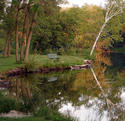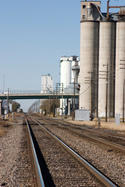I lived in or near cities for 30 years because that’s where the jobs are. I left southwestern Pennsylvania in 1977 as the closing of coal mines and steel mills wrecked the local economy. It cost almost $1,000 per semester to attend the state college, many times that for the state university. There were no opportunities for a young person. I moved to California where residents received free tuition at state universities. I earned 2 college degrees in California and advanced my career from Prudential Insurance through the Federal Reserve Bank and to the Pacific Stock Exchange. read more »
Small Cities
Restless Americans: Migration and Population Change, 2000-2007
Americans may be less mobile than in the past, but millions since 2000 have continued to be on the move, reshaping the landscape and economy of the nation. Three maps will be briefly discussed: one of population change by county, 2000-2007, one of net internal migration by county, and one of net immigration from abroad. We will then focus on the “extremes”, unusually large levels or intensities of net internal migration and of immigration.
Overall population growth read more »
A Grand Alliance: Fostering a North American Central Economic Region
Given current economic trends, the time may be ripe to consider as a concept, an economic region straddling the middle of the North American continent – a North American Central Economic Region (NACER). These cross-border economic regions spanning Northwestern Ontario, Manitoba, North and South Dakota and Minnesota, already share infrastructure, production facilities and research and development capacity. A North American Central Economic Region (NACER) would build on these existing relationships, as well as historic patterns of cultural exchange, cross-border trade, and travel. read more »
- Login to post comments
A Local Graduation: How Small Towns Can Come Back
Pick anytown, USA. You were born there; went to school there; made your living there; had your children and grandchildren and ended your life there. Headstones, like many, tell the story of who came and who went and they helped make the town a unique place.
And so, for a moment, I lamented at how much of that we had lost in the changes we have witnessed over the decades. Here we are in the biggest financial crisis in history, or at least since the Great Depression. What do we do? read more »
- Login to post comments
Time to Reinvent College Towns?
By Joel Kotkin and Mark Schill
For much of their history college towns have been seen primarily as “pass through” communities servicing a young population that cycles in and out of the community. But more recently, certain college communities have grown into “knowledge-based” hot spots --- Raleigh-Durham, Madison, Cambridge and the area around Stanford University --- which have been able to not only retain some graduates but attract knowledge workers and investors from the rest of the country.
But a large proportion of college towns do not seem to be doing so well. read more »
Minnesota's Iron Range Colleges Attracting Business
Being a college president for thirteen years convinced me of the importance of addressing the interdependence between a campus and its town. Inspired by my third presidency, I saw the need to brand a strategy needed to revitalize community.
We gathered 90 stakeholder partners for a full day meeting at Ironworld, a discovery center for the region to preserve its rich heritage and history. The local residents focused efforts on a place-based institution with the capacity to serve as a catalyst for pulling up the towns across Northeast Minnesota. That was in November, 2000. read more »
- Login to post comments
America is More Small Town than We Think
America has become an overwhelmingly metropolitan nation. According to the 2000 census, more than 80 percent of the nation’s population resided in one of the 350 combined metropolitan statistical areas. It is not surprising, therefore, that “small town” America may be considered as becoming a burdensome anachronism.
Nothing could be further from the truth. America is more “small town” than we often think, particularly in how we govern ourselves. read more »
Paper to Paperless: Realigning the Stars
The paper and pulp industry has been good to Wisconsin, the number one papermaking state in the nation. Wisconsin produces more than 5.3 million tons of paper and over a million tons of paperboard annually. The pulp and paper industry employs more than 35,000 people in the state representing roughly eight percent of all manufacturing jobs in Wisconsin. These are good jobs with good benefits. Papermakers earn over 20 percent more than the manufacturing sector average and over 50 percent more than the average wage in the state. read more »
Rural America could bring boon to Dems
By Joel Kotkin and Mark Schill
Perhaps no geography in America is as misunderstood as small towns and rural areas. Home to no more than one in five Americans, these areas barely register with the national media except for occasional reports about the towns’ general decrepitude, cultural backwardness and inexorable decline.
Yet in reality this part of America is far more diverse, and in many areas infinitely more vital, than the big-city-dominated media suspects. In fact, there are many demographic and economic dynamics that make this part of America far more competitive this year than in the recent past. read more »
- Login to post comments
Heartland Infrastructure Investment Key to the Nation’s Growth
By Delore Zimmerman and Matthew Leiphon
Infrastructure investment in America is poised to jump to the front of the policy agenda over the next few years. With the election of the next President, new priorities and objectives are sure to be set on several key issues, including national infrastructure investment. Some of this will be addressed in a major new Congressional transportation funding that will include a major push for all kinds of infrastructure. read more »
- Login to post comments





















